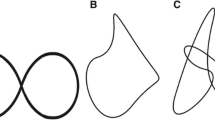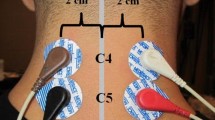Abstract
Background and aims: Although the role of afferent input from cervical muscles on the control of posture and locomotion is recognised, it is surprising that there is an absence of data reporting whether joint position sense at the cervical level is impaired in older healthy adults. The present experiment was designed to address this issue. Methods: Eighteen young (mean age= 23 yrs) and 18 older healthy adults (mean age= 68 yrs) were asked to perform the cervicocephalic relocation test (CRT) to the neutral head position (NHP), that is, to relocate the head on the trunk, as accurately as possible, after active cervical rotation to the left and right sides. Ten trials were performed for each rotation. Absolute and variable errors were used to assess cervical joint repositioning accuracy and consistency, respectively. Results: Less accurate and less consistent repositioning performances were observed in older adults than in young adults, as indicated by increased absolute and variable errors, respectively. Conclusions: The present findings show that cervical joint position sense, assessed through the CRT to the NHP, is impaired in older adults.
Similar content being viewed by others
References
Stump JL. The neuroarticular lesion in the elderly: a condensed literature review. J Manipulative Physiol Ther 2004; 27: e10.
Meeuwsen HJ, Sawicki TM, Stelmach GE. Improved foot position sense as a result of repetitions in older adults. J Gerontol 1993; 48: 137–41.
Robbins S, Waked E, McClaran J. Proprioception and stability: foot position awareness as a function of age and footwear. Age Ageing 1995; 24: 67–72.
Bullock-Saxton JE, Wong WJ, Hogan N. The influence of age on weight-bearing joint reposition sense of the knee. Exp Brain Res 2001; 136: 400–6.
Kaplan FS, Nixon JE, Reitz M, Rindfleish L, Tucker J. Age-related changes in proprioception and sensation of joint position. Acta Orthop Scand 1985; 56: 72–4.
Pai YC, Rymer WZ, Chang RW, Sharma L. Effect of age and osteoarthritis on knee proprioception. Arthritis Rheum 1997; 40: 2260–5.
Petrella RJ, Lattanzio PJ, Nelson MG. Effect of age and activity on knee joint proprioception. Am J Phys Med Rehabil 1997; 76: 235–41.
Skinner HB, Barrack RL, Cook SD. Age-related decline in proprioception. Clin Orthop Relat Res 1984: 208–11.
Goldberg A, Hernandez ME, Alexander NB. Trunk repositioning errors are increased in balance-impaired older adults. J Gerontol A Biol Sci Med Sci 2005; 60: 1310–4.
Roll J, Hay L, Quoniam C, Roll R. Muscle proprioception: a powerful sensory input for postural adaptation in man. In Vellas B, Toupet M, Rubenstein L, Albarede JJ, Christen Y, eds. Falls, balance and gait disorders in the elderly. Paris: Elsevier, 1992: 161–82.
Ferrell WR, Crighton A, Sturrock RD. Age-dependent changes in position sense in human proximal interphalangeal joints. Neuroreport 1992; 3: 259–61.
Bove M, Courtine G, Schieppati M. Neck muscle vibration and spatial orientation during stepping in place in humans. J Neurophysiol 2002; 88: 2232–41.
Vuillerme N, Pinsault N, Vaillant J. Postural control during quiet standing following cervical muscular fatigue: effects of changes in sensory inputs. Neurosci Lett 2005; 378: 135–9.
Gosselin G, Rassoulian H, Brown I. Effects of neck extensor muscles fatigue on balance. Clin Biomech (Bristol, Avon) 2004; 19: 473–9.
Revel M, Andre-Deshays C, Minguet M. Cervicocephalic kinesthetic sensibility in patients with cervical pain. Arch Phys Med Rehabil 1991; 72: 288–91.
Revel M, Minguet M, Gregoy P, Vaillant J, Manuel JL. Changes in cervicocephalic kinesthesia after a proprioceptive rehabilitation program in patients with neck pain: a randomized controlled study. Arch Phys Med Rehabil 1994; 75: 895–9.
Pinsault N, Vaillant J, Virone G, Caillat-Miousse JL, Lachens L, Vuillerme N. Cervicocephalic relocation test: a study of performance stability. Ann Readapt Med Phys 2006; 49: 647–51.
Schmidt R. Motor control and learning. A behavioral emphasis, 2nd ed. Champaign: Human Kinetics Publishers Inc, 1988.
Heikkila H, Astrom PG. Cervicocephalic kinesthetic sensibility in patients with whiplash injury. Scand J Rehabil Med 1996; 28: 133–8.
Mayoux-Benhamou MA, Revel M, Vallee C. Selective electromyography of dorsal neck muscles in humans. Exp Brain Res 1997; 113: 353–60.
Mergner T, Schweigart G, Botti F, Lehmann A. Eye movements evoked by proprioceptive stimulation along the body axis in humans. Exp Brain Res 1998; 120: 450–60.
Taylor JL, McCloskey DI. Illusions of head and visual target displacement induced by vibration of neck muscles. Brain 1991; 114: 755–9.
Vuillerme N, Pinsault N, Virone G, Vaillant J. Effects of cervical muscular fatigue on cervicocephalic joint position sense. Expansion scientifique française ed., Paris, 2005: 48–52.
Miwa T, Miwa Y, Kanda K. Dynamic and static sensitivities of muscle spindle primary endings in aged rats to ramp stretch. Neurosci Lett 1995; 201: 179–82.
Rosant C, Nagel MD, Perot C. Aging affects passive stiffness and spindle function of the rat soleus muscle. Exp Gerontol 2007; 42: 301–8.
Burke JR, Schutten MC, Koceja DM, Kamen G. Age-dependent effects of muscle vibration and the Jendrassik maneuver on the patellar tendon reflex response. Arch Phys Med Rehabil 1996; 77: 600–4.
Rubin AM, Woolley SM, Dailey VM, Goebel JA. Postural stability following mild head or whiplash injuries. Am J Otol 1995; 16: 216–21.
Kristjansson E, Dall’Alba P, Jull G. Cervicocephalic kinaesthesia: reliability of a new test approach. Physiother Res Int 2001; 6: 224–35.
Taylor JL, McCloskey DI. Proprioceptive sensation in rotation of the trunk. Exp Brain Res 1990; 81: 413–6.
Loudon JK, Ruhl M, Field E. Ability to reproduce head position after whiplash injury. Spine 1997; 22: 865–8.
Rix GD, Bagust J. Cervicocephalic kinesthetic sensibility in patients with chronic, nontraumatic cervical spine pain. Arch Phys Med Rehabil 2001; 82: 911–9.
Author information
Authors and Affiliations
Corresponding author
Rights and permissions
About this article
Cite this article
Vuillerme, N., Pinsault, N. & Bouvier, B. Cervical joint position sense is impaired in older adults. Aging Clin Exp Res 20, 355–358 (2008). https://doi.org/10.1007/BF03324868
Received:
Accepted:
Published:
Issue Date:
DOI: https://doi.org/10.1007/BF03324868




